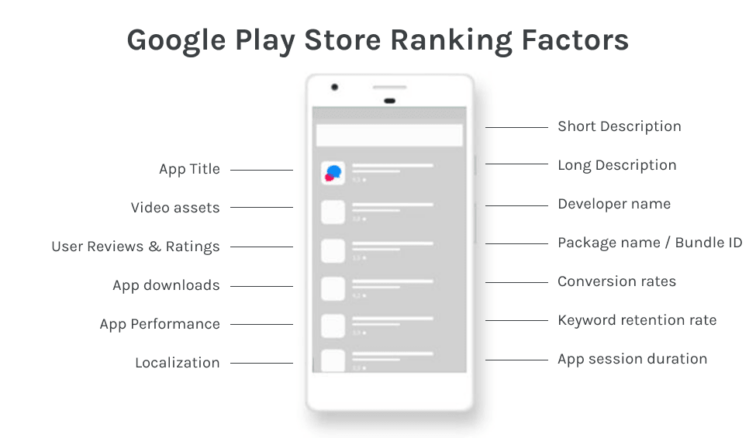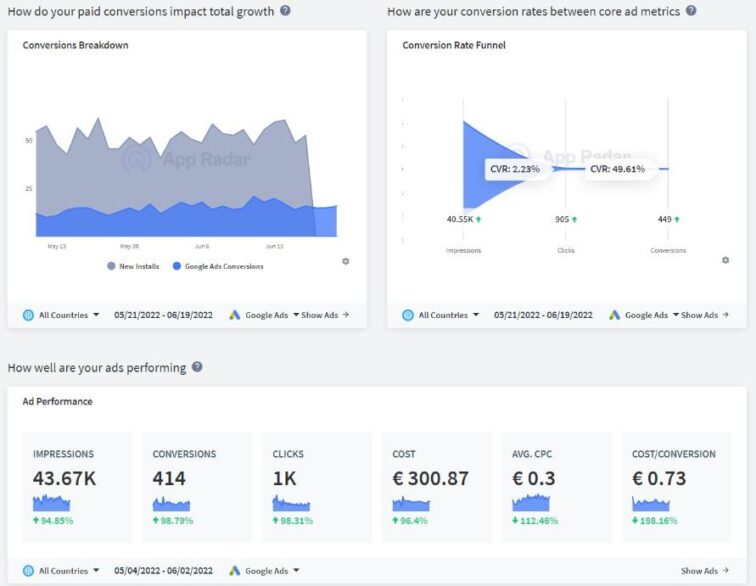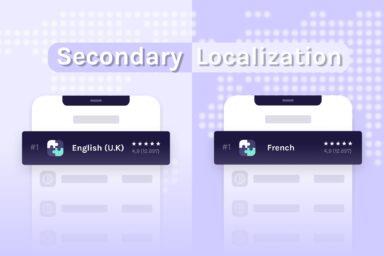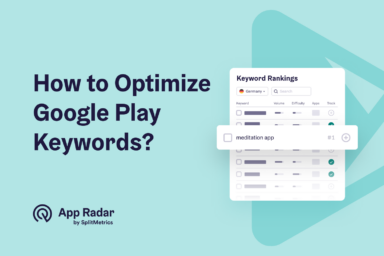Google Play Store Ranking Factors: How to Rank Your App in 2024
Google Play Store uses different algorithms to identify, find and rank high-quality apps for its users. The algorithms use direct and indirect factors that carry different weights and may impact the success of your app differently.

With this article, we’ll help you understand the most crucial ranking factors for Google Play app store optimization (ASO) and help you start working on your app’s organic traffic.
App store optimization is a major factor in growing your app in Google Play. So, if you want to successfully compete with millions of different apps in Play Store, keep reading.
How does the Google Play ranking algorithm work?
Google Play uses keywords as a starting point to understand the users’ search intent. The search algorithm uses search queries to check for apps that need to satisfy a couple of main criteria to have a chance to appear in the search results.
To choose the proper order of the ranking apps, Google Play keeps an index of apps, primarily based on the app keywords placed in metadata. An app has to be relevant for ranking by using the right set of keywords in the metadata. The same app also needs ranking strength based on other factors such as the number of ratings, downloads, conversion rates, retention, etc.
What is the connection between Google Play ranking factors and ASO?
Google Play’s ranking algorithm is a key component of ASO, as it determines which apps are shown to users in search results and other prominent placements.
Understanding and optimizing for Google Play’s ranking factors helps developers significantly improve their app’s visibility and increase downloads.
The more successful you are in providing Google Play with the correct information about your app and having a quality app with an excellent user experience, the higher your chance of getting and keeping high rankings.
Now that you understand the basic principles of Google Play ranking let’s look at the ranking factors.
Sidenote: Google Play Search is the most significant traffic source for most apps. However, your app can also receive traffic from Google Play Explore (users who find your app browsing in the Play Store) and third-party referrers (users coming from untagged deep links). The success of one of these sources will influence the ranking algorithm to give you an additional boost with another source.
What are Google Play ranking factors?
Google Play ranking factors can be direct or indirect. The direct factors consider keywords and their placements, while indirect factors are not directly related to keywords.
Google Play ranking factors are:
- App title
- App’s short and long descriptions
- Developer name
- Package name / Bundle ID
- User ratings and reviews
- App downloads
- Conversion rates
- App performance
- Keyword relevance and density
- App retention rate
- Google tags
- App updates
- Localization
- App session duration
- Video assets
- Privacy and security
Let’s have a look at each of them.

App title
App title is the most important ranking factor in the Play Store. Make sure to place your most important keywords in the app title and that the keywords align with your brand name. You can use a maximum of 30 characters, so carefully plan which keywords you will include.
Placing keywords at the beginning of the app title will give them a bit more weight, but you also need to ensure that your brand name is spotted early on and aligned with Google Play guidelines.
Short description
The second important ranking factor is the short description, which gives app marketers more chances for keyword rankings. You have a maximum of 80 characters to give your users more information about your app.
Although it is tempting to spam this field with keywords, we suggest considering your audience first and then aligning your message with relevant keywords for your app.
Long description
The long description consists of 4,000 characters that you can use to describe how your app works, administrative information, details about your features, etc. Google Play will index the keywords in the long description, but most of your store listing visitors won’t read it.
That is why it is crucial to include the most relevant information in the first five sentences before the “show more” button.
There are no specific rules about keyword density, but we suggest you pay attention to your most important keywords and include them several times in the text.
Developer name
The developer’s name is shown below the app title in the Play Store. The keywords used in the developer name are indexed, and you can update the developer name whenever you want in the account settings in the Google Play Console.
Package name / Bundle ID
Every app in Google Play has a unique package name. You can use that name to put the most important keywords inside for an additional keyword boost. Our experience shows that the package name has less impact than before, but it is still a relevant ranking tactic.
However, package names can’t be changed, so you have to consider the keywords you want to put inside the package name as you launch your app for the first time.
User ratings
User ratings are essential ASO factors but are not under your direct control. However, the user experience and your app quality will massively influence how users perceive your app.
The more positive their experience, the more likely they will reward your app by leaving a high rating. What truly matters for Google Play is how many ratings you receive and the average ratings.
The ratings your app receives are visible in the search results and almost wherever your app is shown in the Play Store. That is why app ratings heavily impact the install conversion rate. Also, the user ratings help your app get featured and reflect the quality, so you should work proactively to obtain user ratings.
User reviews
User reviews in Google Play reflect primarily the quality of your app, as measured by user feedback. The reviews are often combined with user ratings because many users will want to rate your app and leave feedback.
Users who enjoy your app will give you good feedback, and the ranking algorithm indexes the keywords they use to describe their feedback. Although you can’t influence people’s writing, you should always reply to bad reviews and address user concerns.
The unhappy users can change their ratings and review if they feel you helped them with their problem.
App downloads
The number of downloads your app receives is a significant signal to Google Play that shows it is relevant to users. What also matters is the download velocity and the keywords that attract downloads.
The more you work on keyword optimization, the higher the chance you will receive downloads from those keywords, which will help your app store perform better.
Conversion rates
If your Google Play listing has properly optimized metadata, asset visuals and receives impressions from the audience, your app will start receiving store listing visitors.
If store listing visitors use specific keywords to visit your listing and download your app, it will signal to the ranking algorithm that your app is a good fit for those keywords. That is why it is vital always to examine the complete user funnel and work on improving the conversion rates for each step users take on their journey. We suggest creating and following your own set of app KPIs and metrics to ensure you are on the right track.
App performance
Google Play uses Android vitals to assess an app’s health and from the technical and user experience. Android vitals consider a range of technical thresholds, and among the most crucial ones are ANR rates (app not responding) and app crashes.
Low values can impact the keyword rankings and bring fewer installs, so you should monitor them continuously.
The most important app performance vitals that are especially significant for Google Play Store ranking are:
- Crash Rate
- Excessive Wakeups
- Stuck Partial Wake Locks
- Excessive Background Usage
- Slow Rendering
If you notice warnings in your Google Play Console, address the issues with your developer team on time before users complain about your app’s performance.
Keyword relevance and density
The strategic placement and density of keywords within the app’s metadata can also have a solid role, although we can’t say to which extent exactly. However, we do know that the Play Store algorithm prioritizes keywords that are used multiple times and positioned early in the long description.
So, as an ASO expert, you have to think about how to make your app visible to the Play Store users. But you also have to think about how the Play Store algorithm works – which is more than just stuffing keywords.
Keyword indexation
A couple of words about keyword indexation: Google Play’s algorithm indexes apps based on the keywords explicitly mentioned in the app’s metadata (title, short description, and long description) and considers related terms such as synonyms and contextually similar words. This is made possible with advanced machine learning techniques, especially now that Google also introduced its Gemini model. Google Play is getting smarter and it will always try to understand the semantic relationships between keywords paired with user interactions and behavior.
App retention rate
App retention rate is another significant signal to Google Play. If users install your app but then quickly remove it from their devices, it shows that your app is not the best fit for what they are looking for.
Additionally, Google looks for keywords that bring installs and app retention rates. Although you can’t control this, you should constantly monitor which keywords most likely bring the most app downloads.
The best way to check those keywords is in Google Play Console or directly in App Radar.
If your retention rate is lower than that of your peer groups, your app is not fulfilling user expectations. At that point, you should consider improving your app or testing keywords that might lead to higher retention rates.
Google tags
Google tags categorize apps and boost their discoverability. They also determine the peer groups with which an app is compared. Furthermore, tags appear in search results, offering users a quick snapshot of the app’s content and functionality.
App updates
Although not a new factor, the frequency and quality of app updates are becoming increasingly important. Apps that consistently roll out updates featuring bug fixes, performance enhancements, and new features may be preferred by app store algorithms.
Localization
App localization hasn’t been confirmed as a ranking factor, but it significantly influences conversion rates. Local users like to see the apps in their language and are more likely to install a localized app.
Localizing your store listings results in higher conversion rates and could help Google Play by giving an advantage to localized apps over non-localized ones. Google Play suggests working on the app localization in the official documentation as well.
App session duration
App session duration is not a ranking factor but could give Google Play information on user signals. The ranking algorithm can recognize if users launch an app after installing it and how long they are using it.
Based on that, the duration and number of sessions could be a potential ranking factor.
Video assets
While promo videos in Google Play are not a ranking factor, Google Play suggests video assets because they help users understand the app better. Even if a promo video is not a ranking factor, you should always test your store listing performance with and without the video.
How to rank your app higher in Google Play?
Knowing what matters is just the first step in ranking higher in Google Play. You also need to build an ASO strategy that guides your efforts and consistently improves your store listings.
ASO Keyword Optimization
We already mentioned that keywords contribute massively to app store rankings. That is why you should start thinking about the keyword optimization process.
Many ASO experts will suggest you divide keyword strategy into four main categories:
- Research the keywords by talking to industry experts, your team or by using tools
- Classify and prioritize keywords based on their relevance, popularity, and competition
- Decide how and where you will target those keywords
- Measure the impact of your efforts and track the results and effects
For the maximum impact, you will want to combine your keyword strategy with other tactics, such as improving your app conversion rate. Your Google Play app icon, screenshots, and promo video are essential for attracting users and significantly impacting conversions.
You will want to test different visual assets and keep those that will attract the users.

The importance of user management and experience
User management might be a big part of your daily ASO efforts. Dedicate resources to communicating with your app users and improving their experience.
Many apps have an international audience, so you need to consider the localization of your store listings and if your app installs are influenced by seasonality.
The more relevant your app is to your audience, the more likely you will experience higher conversion rates and climb the ratings. If you have a quality app that attracts many positive user ratings, you will have a good chance of being featured, which can impact your traffic and rankings.
Just remember that ASO requires continuous effort, and you must work on it constantly if you want to climb in the Play Store.
Increase positive ratings and reviews
Securing positive ratings and reviews boosts your app’s credibility and ranking on the Google Play Store.
Encourage satisfied users to leave positive feedback by prompting them at appropriate moments within the app, such as after completing a task or enjoying a feature.
Additionally, prioritize responding to negative reviews promptly and professionally, addressing user concerns and demonstrating your commitment to improving their experience.
This proactive approach not only helps in maintaining a positive reputation but also shows you care about your loyal app users.
App conversion rate optimization
Optimizing your app conversion rate plays a huge role in increasing downloads and improving its ranking on the Google Play Store.
Start by crafting an engaging store listing with high-quality screenshots and videos that showcase your app’s interface and functionality. Highlight your app’s unique features and benefits to persuade users to download, and leverage Google Play Experiments to A/B test various elements of your listing to identify the most effective variations.
Additionally, consider offering a trial experience with Google Play Instant to reduce barriers to entry and boost user confidence. Participating in the Google Play Points program can further incentivize user engagement, potentially leading to increased visibility and higher conversion rates.
Why is tracking app keyword rankings important for higher app store rankings?
Tracking keyword rankings is among the most critical ASO tactics. Improving your Google Play rankings will be almost impossible if you don’t know what you rank for, at which position, and how important a particular keyword is.
Especially when you make changes to your store listing, you will need to track its effectiveness.
The Google Play algorithm usually takes more than one day to index your new keywords. You will often notice that after you make a store listing update, your current and new keywords will fluctuate for some.
Monitoring your keyword rankings and their positions has to be on your daily or weekly list of activities.
Even if you jump from position #50 to position #3, it doesn’t mean a lot of people use that keyword. Sometimes, you may rank at position 8 for a popular keyword and get more downloads than ranking #1 for a keyword with a low search volume.
As a rule of thumb, ranking lower than position #10 in Google Play will probably not impact your KPIs, and your keyword rankings should contribute to KPIs.
In short, paying attention to keyword rankings will ensure that you identify, prioritize, and work on pushing the keywords that are important to your business.
How many downloads do the best Android apps get?
The mobile app community is often interested in the number of downloads needed to be among the top apps. Google Play and App Store calculate top chart rankings, which consist of the top apps in their category.
The formula for calculating those top apps includes mostly download velocity or download revenue, user engagement, and star ratings.
Top chart rankings are calculated daily and are very volatile. Research shows that less than 25% of apps in Google Play stay among the top 100 for a year.
It is normal to see new apps jumping up and down for more than 50 places in one day. So, if you are trying to climb up in the rankings in your category, you can start by looking at the most popular apps in the top charts for your category. This analysis will help you understand what your competitors do and the competitor benchmark.
For example, here is the list of the most downloaded games in Google Play as of July 2025.
If you have a game app that competes with one of these apps, you must think carefully about your ASO strategy and long-tail keywords that you can rank for.
ASO Tools to use for better rankings in Google Play
To optimize your app and increase its rankings in the Play Store, you will need to consider different ASO tools as well as the ones that save you time and provide ASO insights.
The mobile app industry is flooded with tools that promise high rankings and quick results, but the reality looks different.
To start, familiarize yourself with the Google Play Console. If you want to publish an app listing in the Play Store, you must provide metadata information and the mandatory number of store assets (app icons and screenshots).
However, Google Play Console offers much more for app marketers. There are many possibilities to analyze your conversion rates, app performance, and user management, including Store listing experiments for A/B testing and custom store listings for targeting specific app users.
The other tool you should use is an ASO tool. It will save you a lot of time and provide information on competitors, keywords, conversion rates, and everything else you need to work on to improve your Google Play rankings.
There are many ASO tools in the market, and App Radar is one of them. We are a bit biased, but with App Radar you can find almost everything you need to optimize and grow your app in the App Radar platform.
Finally, if you are investing in app campaigns and paid user acquisition, consider using a mobile measurement partner (MMP or mobile attribution tool). These tools can be pretty expensive but are definitely worth the money.
However, if your primary focus is app store optimization, App Radar integrates with Google app campaigns so that you can monitor your organic and paid traffic in one tool.

Do paid campaigns influence Google Play rankings?
Paid campaigns play a significant role in user acquisition, and many app marketers use them to complement their ASO efforts. Could they also influence your organic rankings in Google Play? The answer is yes, but indirectly.
In the above section, we mentioned that downloads your app receives are a quality signal for Google Play and that downloads influence ranking. Assuming that your paid campaigns are bringing you downloads and installs, your app will get an additional boost in the Play Store. The result will be increased visibility in search results and the browse category.
More visibility will bring more users to your organic store listing, and many will bring you organic downloads. So, if executed correctly, paid campaigns can initiate a growth loop that reinforces your existing marketing efforts.
Final advice on ranking in Google Play
To grow your rankings in Google Play, you must get the fundamentals first. Start by working on your ASO strategy that addresses ranking factors. Create a keyword optimization process where you research, implement and test keywords that have search potential relevant to your app.
You will also need to work on other ASO tactics, such as app conversion rates, localizations, managing ratings and reviews, competition analysis and so on.
App Radar has many tools inside its platform to give you a competitive edge. Test it for free for 7 days, and you will see how much it helps with app store optimization.
Latest Posts

iOS App Product Page Localization: How to Use it the Right Way to Improve ASO
Top 10 Most Downloaded Games in Google Play Store (July 2025 Update)
Google Play Store Listing Experiments: How to Run Native A/B testing for Android Apps for Free!
12 Best Mobile Measurement Partners (MMPs) to Consider for Your Mobile App Attribution in 2025
Academy Lessons
Continue lessons

